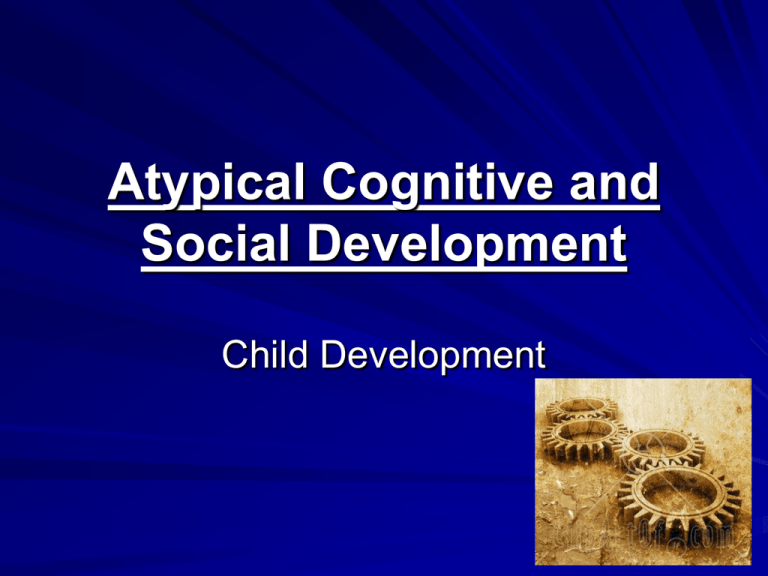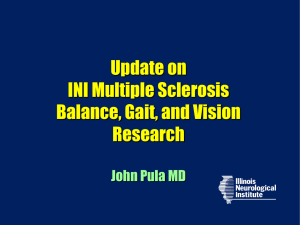Atypical Cognitive and Social Development
advertisement

Atypical Cognitive and Social Development Child Development Objectives 1. Analysis of the strengths and weaknesses of theoretical frameworks for conceptualizing atypical patterns of cognitive and Social development. 2. Familiarity with major research findings regarding atypical patterns of cognitive and social development. Kleinberg (1982) "The child faces a variety of developmental tasks. These are determined by such factors as physical maturation, increasing cognitive and communicative capacities and changing social and affective needs" (p. 23). Disabling conditions interfere with ‘typical’ growth and development, psychologically, cognitively and physically. Disability can negatively effect ‘normal’ cognitive development. The major paradigms that have been used in conceptualizing and studying atypical cognitive and social development include Constructivism, Information Processing, Socioculturalism, (Social) Learning Theory, and Bioadaptation. Issues related to perceptual organization, memory, concepts of physical and social causality, problem-solving, formation of social relationships, self-awareness and selfregulation, and social inferencing. Empirical studies of cognitive development usually report the abilities that children display at different ages. The cognitive mechanisms that allow a child with a disability to move from one set of abilities to a more complex set remain shrouded in mystery. Erikson’s Stage Model According to Erikson's stages of development, tasks which must be mastered at each stage may be short circuited by the intrusion of a disability. Lack of mastery of certain tasks at particular stages leads to non-mastery or the negative counterpart of each stage. The disabled child may suffer more from the lack of mastery of certain tasks than from the disability itself. The theory can give the caregiver an idea of what accomplishments a child may achieve at each level, and help support the child at each stage to reach their full potential. In comparison, the theory can support discriminatory notions of disability and reinforce that disability is a weakness. Piaget Piaget's (1970) cognitive theory is age-dependent and suggests that the ability to reason develops through specific age-stage periods future skills depending on the mastery of those before. A process of acquiring mental representations of increasing complexity: assimilation, accommodation and equilibration. Running throughout Piaget's theory is the need for an individual to move, explore, master, construct through play and movement and the use of language to recall or categorize what has been learned (Anastasiow, 1986). Theory stresses individual's need to interact with the environment. If the environment is safe then normal cognitive development can take place along with normal psychosocial development. Therefore, disability can effect the psychosocial development, which, in turn, can greatly effect the cognitive growth of the individual at every stage. Theory has been used as a diagnostic tool. Assert that children with intellectual disabilities pass through the same stages of maturation but at a slower stage. Some individuals do not reach the higher level of formal operational thinking. Westwood (1989) School age children with moderate learning difficulties tend to function at the ‘concrete operational’ stage. Whereas youngsters who live with severe learning disabilities ‘sensori-motor’ or ‘preoperational’ Commonsense methods for children with special educational needs. Westwood (1989) Research findings in learning disabilities based on Piaget's theory were reviewed by Fakouri (1991) . Superimposing the findings of research on Piagetian stages of cognitive development, it appears that during the sensorimotor stage the diagnosis of learning disabilities is difficult. The research findings suggest that there is a delay in cognitive development of learningdisabled children during elementary school years, which corresponds to preoperational, concrete operational, and transition to formal operational stages. From a genetic epistemological perspective, research evidence supports a developmental lag approach to learning disabilities. This research has Implications for assessment, curriculum planning, and education provision. M. E. Fakouri Psychology in the Schools. Volume 28, Issue 1 , Pages70 - 76. Copyright © 1991 Wiley Periodicals, Inc., A Wiley Company Research has supported the idea that Piagetian teaching methods can improve cognitive abilities of children who experience impairment. Williams (Journal of intellectual disability research, 1996) used a simplified version of Piaget's sensorimotor levels was employed to teach a group of 25 extremely impaired individuals who live in a large residential home. Using this tool, an average of 13% of individuals from the common population pool increased their scores over a 6-year time period. All of the individuals who received training within the experimental group demonstrated increased scores. Scores increased such that an average gain of nearly I month in overall age equivalency per individual per year was realized. A matched group comparison, a prediction test for like sensorimotor skill attainment (the primary distinction of this curriculum methodology), and an historical review of subject skill training, all support the cognitively geared methodology as being primarily responsible for this accelerated progress. Vygotsky & Social Constructionist Theories Dynamic nature of disability: constant changes in the structure and content of a disability take place during development and under the influence of Social factors. Human development is a socio-genetic process carried out in social activities. Education "leads" development which is the result of social learning through the internalization of culture and social relationships. Development is not a straight path of quantitative gains and accumulations, but a series of qualitative, dialectic transformations, a complex process of integration and disintegration. Vygotsky considered disability as a “social aberration” (1993: p 66), informed from children’s changing social, environmental relations. Introduced a practice-oriented paradigm for the education of children with special needs - Dysontogenesis (TD) (Karpov 2005:10). Concept of primary defects (organic defects), secondary defects (“cultural consequences of primary defects”), and their interaction - a disability-specific ‘Zone of proximal development’. Disability is considered as a socio-cultural developmental phenomenon where compensation will have to come from socialization and cultural support. Vygotsky claimed that the most efficient compensation for the loss or weakness of natural functions can be achieved through the development of the higher mental functions - implementation of a “positive differential approach”. The development of the individual with a disability is not "sloweddown" or "missing" variations of normal development. "A child whose development is impeded by a disability is not simply a child less developed than his peers; rather, he has developed differently." (Vygotsky, 1983, p. 96). Theory implies a favourable societal view on children with disabilities, directing the focus point not on weaknesses and disorders, but on the strengthening and empowerment of individual skills. Biomedical Approaches Sheridan – developmental progress using concrete cognitive, social and physical norms. Traditionally, a child with a disability has been considered to be either "underdeveloped/developmentally delayed“. According to this model, disability is identified with illness or impairment. From this perspective, in order to understand a disability, the background and health conditions must be understood as the disability is part of what is 'wrong' with the person. Under this definition, this medical condition resides entirely with the individual and is considered unchanging across cultures. The difference between a child with a disability and his/her non-disabled peer is only quantitative. Critique of Theories Theories of development as normative frameworks. Societal expectations regarding 'typicality' and normality which have an impact on how professionals identify and respond to atypical developmental patterns. Identified boundaries of deviation from developmental norms – different and ‘sub-normal’. Lubeck (1996) Over-simplification fails to deal with the diversity of children’s development. Pecheux (1999) predictive ‘developmental timescales’ are too inequitable and can not be applied to minority groups. Hauser-Cram (2001) Social diversity of human development rather than biological universality. Children as ‘incomplete-adults’. The perceived cognitive norms and competences of adulthood define the norms of child development. Supports notion that children with disabilities are ‘failing’ to be autonomous adult citizens that modern society requires in the workforce. Labelling theory – Learning difficulties, developmental disability – incomplete people. Correction of biological and cognitive characteristics of children. The Social Model encourages us to improve Social structures and institutions this ‘dis-able’ the individual. Social responses to childhood in contemporary society need to be more flexible to the diversity of human development (Preistly, 2003). Moving to an Ecological approach in Cognitive Development. This theory looks at a child’s development within the context of the system of relationships that form his or her environment. Bronfenbrenner’s theory defines complex “layers” of environment, each having an effect on a child’s development. “Bioecological systems theory” to emphasize that a child’s own biology is a primary environment fuelling her development. The interaction between factors in the child’s maturing biology, his immediate family/community environment, and the societal landscape fuels and steers his development. Changes or conflict in any one layer will ripple throughout other layers. To study a child’s development then, we must look not only at the child and her immediate environment, but also at the interaction of the larger environment as well. Ecological Model Existentialism and Development Existentialism – focuses on the whole structure of personal and inter-personal being and the necessity to encourage freedom and responsibility. Potential for growth. Uniqueness of the individual Maslow, Rogers Final Thoughts Ecological and Existential approaches to development incorporate the concepts of the Social Model of Disability - “It is society that disables us, not our impairments.” The social model of disability represents a challenge to traditional thinking about social and cognitive development. It has the potential to transform policies and practice as well as the lives of people who live with a disability. However, too-easy acceptance of the new disability paradigm may even be counterproductive: by being so easy it runs the risk of ignoring how negative assumptions and attitudes about disability (held by both disabled and non-disabled people) are so deeply ingrained and continually reinforced. Require a genuine awareness of the unequal power relationships that define developmental understanding and theory, and its relationship with disability, gender and ethnicity.






